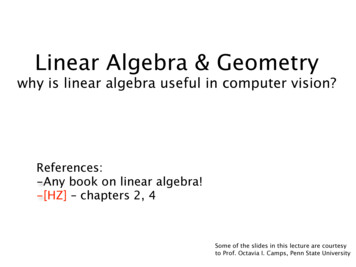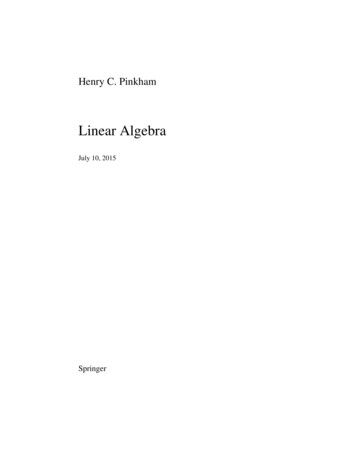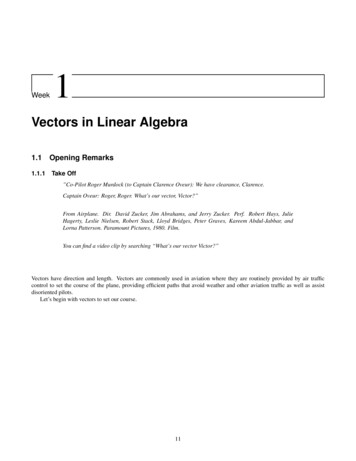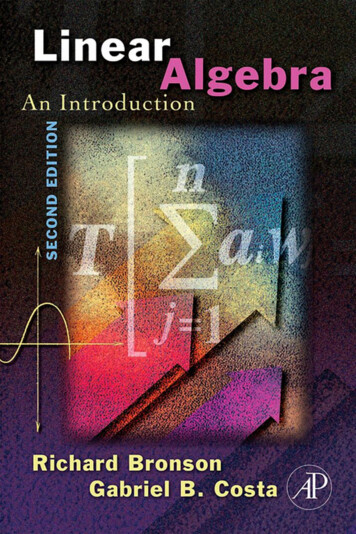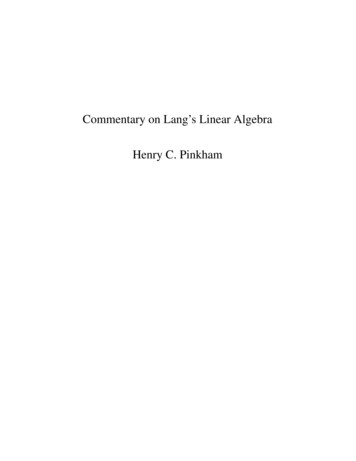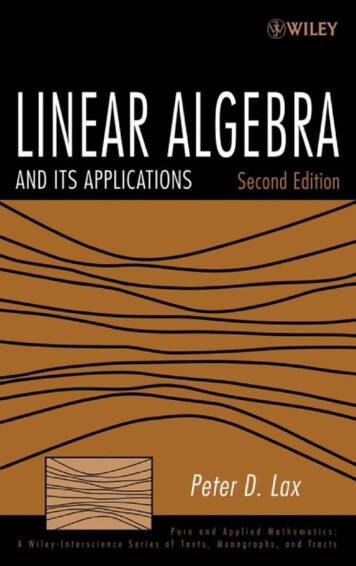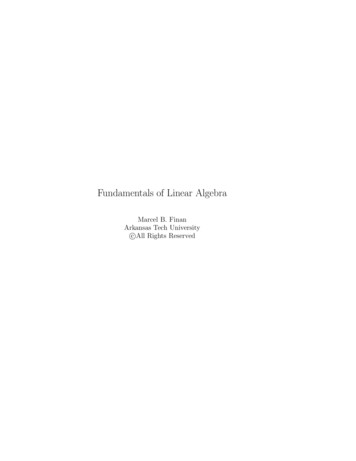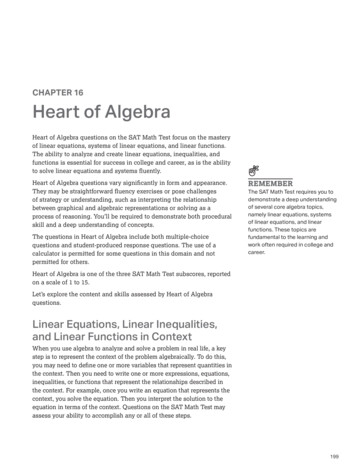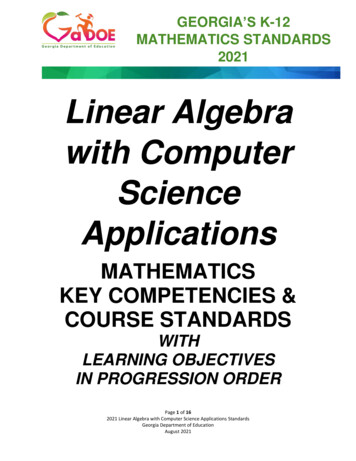
Transcription
GEORGIA’S K-12MATHEMATICS STANDARDS2021Linear Algebrawith ComputerScienceApplicationsMATHEMATICSKEY COMPETENCIES &COURSE STANDARDSWITHLEARNING OBJECTIVESIN PROGRESSION ORDERPage 1 of 162021 Linear Algebra with Computer Science Applications StandardsGeorgia Department of EducationAugust 2021
GEORGIA’S K-12MATHEMATICS STANDARDS2021Governor Kemp and Superintendent Woods are committed to the best set of academic standardsfor Georgia’s students – laying a strong foundation of the fundamentals, ensuring age- anddevelopmentally appropriate concepts and content, providing instructional supports to set ourteachers up for success, protecting and affirming local control and flexibility regarding the use ofmathematical strategies and methods, and preparing students for life. These Georgia-owned andGeorgia-grown standards leverage the insight, expertise, experience, and efforts of thousands ofGeorgians to deliver the very best educational experience for Georgia's 1.7 million students.In August 2019, Governor Brian Kemp and State School Superintendent Richard Woodsannounced the review and revision of Georgia's K-12 mathematics standards. Georgians havebeen engaged throughout the standards review and revision process through public surveys andworking groups. In addition to educator working groups, surveys, and the Academic ReviewCommittee, Governor Kemp announced a new way for Georgians to provide input on thestandards: the Citizens Review Committee, a group composed of students, parents, business andcommunity leaders, and concerned citizens from across the state. Together, these efforts wereundertaken to ensure Georgians will have buy-in and faith in the process and product.The Citizens Review Committee provided a charge and recommendations to the working groupsof educators who came together to craft the standards, ensuring the result would be usable andfriendly for parents and students in addition to educators. More than 14,000 Georgiansparticipated in the state's public survey from July through September 2019, providing additionalfeedback for educators to review. The process of writing the standards involved more than 200mathematics educators -- from beginning to veteran teachers, representing rural, suburban, andmetro areas of our state.Grade-level teams of mathematics teachers engaged in deep discussions; analyzed stakeholderfeedback; reviewed every single standard, concept, and skill; and provided draftrecommendations. To support fellow mathematics teachers, they also developed learningprogressions to show when key concepts were introduced and how they progressed across gradelevels, provided examples, and defined age/developmentally appropriate expectations.These teachers reinforced that strategies and methods for solving mathematical problems areclassroom decisions -- not state decisions -- and should be made with the best interest of theindividual child in mind. These recommended revisions have been shared with the AcademicReview Committee, which is composed of postsecondary partners, age/development experts,and business leaders, as well as the Citizens Review Committee, for final input and feedback.Based on the recommendation of Superintendent Woods, the State Board of Education will voteto post the draft K-12 mathematics standards for public comment. Following public comment, thestandards will be recommended for adoption, followed by a year of teacher training andprofessional learning prior to implementation.Page 2 of 162021 Linear Algebra with Computer Science Applications StandardsGeorgia Department of EducationAugust 2021
Linear Algebra with Computer ScienceApplicationsOverviewThis document contains a draft of Georgia’s 2021 K-12 Mathematics Standards for theHigh School Linear Algebra with Computer Science Applications Course, which is a fourthmathematics course option in the high school course sequence.The standards are organized into big ideas, course competencies/standards, and learningobjectives/expectations. The grade level key competencies represent the standardexpectation of learning for students in each grade level. The competencies/standards areeach followed by more detailed learning objectives that further explain the expectationsfor learning in the specific grade levels.New instructional supports are included, such as clarification of language andexpectations, as well as detailed examples. These have been provided for teachingprofessionals and stakeholders through the Evidence of Student Learning Column thataccompanies each learning objective.Course Description:Linear Algebra with Computer Science Applications is designed to meet the needs ofadvanced students who have completed GSE Pre-Calculus or Accelerated GSE PreCalculus or the equivalent and will pursue careers which require linear algebra topicsoften associated with modern computer science.The course will examine the use of vectors and matrices in mathematics and apply theseconcepts to computer science. There will be a strong focus on the presentation ofmathematical ideas through both writing and programming. Mathematical concepts, suchas vector spaces and Markov chains, will be presented through an abstract approach thatcharacterizes upper-level mathematics courses. The goal is to give students the skills andtechniques they will need as they study advanced mathematics or computer science atthe college level. This is an alternative course for those students who do not wish to enrollin an Advanced Placement course, but who still wish to learn higher-level mathematics.Course Description:This course is designed for students who have successfully completedGSE Pre-Calculus or Accelerated GSE Pre-Calculus.Page 3 of 162021 Linear Algebra with Computer Science Applications StandardsGeorgia Department of EducationAugust 2021
Georgia’s K-12 Mathematics Standards - 2021Mathematics Big Ideas and Learning Progressions, HighSchoolMathematics Big Ideas, HSHIGH SCHOOLMATHEMATICAL PRACTICES (MP)MATHEMATICAL MODELING (MM)NUMERICAL (QUANTITATIVE) REASONING (NR)PATTERNING & ALGEBRAIC REASONING (PAR)FUNCTIONAL & GRAPHICAL REASONING (FGR)GEOMETRIC & SPATIAL REASONING (GSR)DATA & STATISTICAL REASONING (DSR)PROBABILISTIC REASONING (PR)ABSTRACT & DIGITAL REASONING (ADR)The 8 Mathematical Practices and the Mathematical Modeling Frameworkare essential to the implementation of the content standards presented inthis course. More details related to these concepts can be found in the linksbelow and in the first two standards presented in this course:Mathematical PracticesMathematical Modeling FrameworkPage 4 of 162021 Linear Algebra with Computer Science Applications StandardsGeorgia Department of EducationAugust 2021
Linear Algebra with Computer Science ApplicationsThe nine course standards listed below are the key content competencies students will be expected to master in this course.Additional clarity and details are provided through the classroom-level learning objectives and evidence of student learningdetails for each course standard found on subsequent pages of this document.COURSE STANDARDSLACS.MP: Display perseverance and patience in problem-solving. Demonstrate skills and strategies needed to succeed inmathematics, including critical thinking, reasoning, and effective collaboration and expression. Seek help and applyfeedback. Set and monitor goals.LACS.MM.1: Apply mathematics to real-life situations; model real-life phenomena using mathematics.LACS.ADR.2: Investigate and describe real-life problems in linear algebra using an object-oriented programming language.LACS.GSR.3: Solve contextual, mathematical problems involving vectors to explain real-life phenomena.LACS.PAR.4: Solve contextual, mathematical problems involving matrices to explain real-life phenomena.LACS.GSR.5: Solve contextual, mathematical problems involving matrices as geometric transformations and to explainreal-life phenomena.LACS.PR.6: Using probabilistic and quantitative reasoning, solve contextual, mathematical problems using Markov chainsto explain real-life phenomena.LACS.PAR.7: Solve contextual, mathematical problems using vector spaces to explain real-life phenomena.LACS.PAR.8: Solve contextual, mathematical problems using eigenvalues and eigenvectors to explain real-life phenomena.Page 5 of 162021 Linear Algebra with Computer Science Applications StandardsGeorgia Department of EducationAugust 2021
Linear Algebra with Computer Science ApplicationsMATHEMATICAL MODELINGLACS.MM.1: Apply mathematics to real-life situations; model real-life phenomena using mathematics.ExpectationsLACS.MM.1.1Explain contextual, mathematical problems using a mathematicalmodel.LACS.MM.1.2Create mathematical models to explain phenomena that exist in thenatural sciences, social sciences, liberal arts, fine and performingarts, and/or humanities contexts.LACS.MM.1.3Using abstract and quantitative reasoning, make decisions aboutinformation and data from a contextual situation.Use various mathematical representations and structures with thisinformation to represent and solve real-life problems.LACS.MM.1.4Evidence of Student Learning(not all inclusive; see Course Overview for more details)Fundamentals Students should be provided with opportunities tolearn mathematics in the context of real-life problems. Contextual, mathematical problems are mathematicalproblems presented in context where the contextmakes sense, realistically and mathematically, andallows for students to make decisions about how tosolve the problem (model with mathematics).Fundamentals Students should be able to use the content learned inthis course to create a mathematical model to explainreal-life phenomena.ABSTRACT & DIGITAL REASONING – ProgrammingLACS.ADR.2: Investigate and describe real-life problems in linear algebra using an object-oriented programminglanguage.ExpectationsEvidence of Student Learning(not all inclusive; see Course Overview for more details)Use an object-oriented programming language to complete computer programming tasks.LACS.ADR.2.1 Utilize sets, lists, dictionaries, indexing, and tuples in programminglanguages.ExamplesLACS.ADR.2.2 Show and explain how to program and apply modules and controlstatements in programming languages.LACS.ADR.2.3 Loops and conditionals such as if-then-else, for, andwhile-doProgram input and output features to read from and write to files in aprogramming assignment.Page 6 of 162021 Linear Algebra with Computer Science Applications StandardsGeorgia Department of EducationAugust 2021
GEOMETRIC & SPATIAL REASONING – VectorsLACS.GSR.3: Solve contextual, mathematical problems involving vectors to explain real-life phenomena.ExpectationsEvidence of Student Learning(not all inclusive; see Course Overview for more details)Use vectors to find and interpret geometric relationships.LACS.GSR.3.1Use coordinates to represent points in n dimensions and define anduse arithmetic operations on n-dimensional points.LACS.GSR.3.2Use vectors to find and interpret geometrical relationships betweenpoints in two and three dimensions, such as distance, and generalizethese relationships to higher dimensions using n-dimensionalvectors.LACS.GSR.3.3Interpret adding, scaling, and linear combinations of vectorsgeometrically and algebraically.Fundamentals Students should be provided opportunities todemonstrate understanding of geometricinterpretations of vectors.Fundamentals Students should be provided opportunities todemonstrate understanding of geometricinterpretations of vectors.Use the dot product and the cross product of two vectors to find and interpret geometric relationships.ExamplesLACS.GSR.3.4Find and use the dot product of two n-dimensional vectors. LACS.GSR.3.5Use properties of the dot product to prove statements about vectorsand to solve problems in context.LACS.GSR.3.6LACS.GSR.3.7Use the triangle inequality in n-dimensions.Find and use the cross product of two 3-dimensional vectors.Solve applied problems involving vectors using programming.LACS.GSR.3.8Represent and perform vector operations using programminglanguage classes that define the use of vectors.LACS.GSR.3.9Apply perfect secrecy, all-or-nothing secret sharing, and solving lightsout games to vectors over GF(2).LACS.GSR.3.10 Use vector operations to program simple authentication schemes.Determine whether two vectors are orthogonal usingthe dot product; find the projection of a vector alonganother; and find the angle between two vectors.Examples Prove that the dot product of a vector with itself isequal to the square of the vector’s magnitude.Relevance and Application Find the angle between two vectors.Examples Given two vectors, find a vector orthogonal to the twovectors; find the areas of triangles andparallelograms.ExamplesRepresent a vector as an array of real numbers Page 7 of 162021 Linear Algebra with Computer Science Applications StandardsGeorgia Department of EducationAugust 2021
PATTERNING & ALGEBRAIC REASONING – MatricesLACS.PAR.4: Solve contextual, mathematical problems involving matrices to explain real-life phenomena.ExpectationsEvidence of Student Learning(not all inclusive; see Course Overview for more details)Use matrices to solve systems of linear equations.LACS.PAR.4.1Represent a linear system of three equations in three variables as anaugmented matrix and reduce the matrix to row-echelon form.LACS.PAR.4.2Interpret the nature of the solution of a system from its row-echelonform, and if there are infinitely many solutions, express them as avector equation.LACS.PAR.4.3Determine whether a vector is a linear combination of other givenvectors; find the linear combination of vectors that results in a givenvector.Interpret linear dependence of vectors geometrically.Find the kernel of a matrix and explore the relationship between thekernel, the orthogonality of the vectors in the kernel, and the lineardependence of the rows/columns.Operations on and with matrices.LACS.PAR.4.6Add two matrices, multiply a matrix by a scalar, find the transpose ofa matrix.LACS.PAR.4.7Determine when matrix multiplication is defined, and if defined,multiply two matrices by considering the matrix product as a dotproduct of a group of vectors.LACS.PAR.4.8Determine when the inverse of a square matrix exists, and if it exists,find it by augmenting the identity matrix to the matrix and then userow operations.LACS.PAR.4.9Decompose a matrix into its symmetric and skew-symmetric parts;decompose a matrix into its LU factorization.LACS.PAR.4.10 Solve a matrix equation using inverses; find all solutions to a matrixequation given one solution and the kernel.Solve applied problems involving matrices using programming.LACS.PAR.4.11 Improve the simple authentication scheme over GF(2).LACS.PAR.4.12 Show and explain how threshold secret sharing works in conjunctionwith Gaussian elimination through programming.LACS.PAR.4.13 Write code utilizing error-correcting concepts.Fundamentals Students should be given opportunities to interpretvectors written in i-j-k form as a linear combinationthe vectors i, j, and k.LACS.PAR.4.4LACS.PAR.4.5Example Hamming’s codePage 8 of 162021 Linear Algebra with Computer Science Applications StandardsGeorgia Department of EducationAugust 2021
GEOMETRIC & SPATIAL REASONING – MatricesLACS.GSR.5: Solve contextual, mathematical problems involving matrices as geometric transformations and to explainreal-life phenomena.ExpectationsEvidence of Student Learning(not all inclusive; see Course Overview for more details)Find and use matrices which represent geometric transformations.LACS.GSR.5.1Given a 2-by-2 or 3-by-3 linear transformation matrix, describe thetransformation a geometric figure undergoes.FundamentalsStudents should be provided opportunities todemonstrate understanding of geometricinterpretations of matrices. LACS.GSR.5.2Find matrices that represent scalings, reflections, and rotations ofgeometric figures.LACS.GSR.5.3 Find a matrix that represents a combination of transformations.LACS.GSR.5.4 Find the image of a point under a transformation.LACS.GSR.5.5 Find the area of a polygon given its coordinates using matrices; findthe area of the image of a polygon after a transformation.LACS.GSR.5.6 Write code to perform transformations in two-dimensional geometryusing matrix operations.Use matrices as functions.LACS.GSR.5.7 Define functions from n dimensions to m dimensions as vectorsand/or matrices.LACS.GSR.5.8 Find the image and preimage of a linear map using matrices;determine whether the linear map is one-to-one.LACS.GSR.5.9 Find and interpret geometrically the set of preimages of a vectorunder a given matrix.PROBABILISTIC REASONING – Markov ChainsLACS.PR.6: Using probabilistic and quantitative reasoning, solve contextual, mathematical problems using Markovchains to explain real-life phenomena.ExpectationsEvidence of Student Learning(not all inclusive; see Course Overview for more details)LACS.PR.6.1LACS.PR.6.2Model a finite random process using transition matrices in a Markovchain.Simulate the different stages of a Markov chain using randomnumbers.Page 9 of 162021 Linear Algebra with Computer Science Applications StandardsGeorgia Department of EducationAugust 2021
R.6.7Use matrix algebra to calculate the probability of future states of aMarkov chain.Determine the attractor for a regular Markov chain.Use transition matrices to identify absorbing states of a Markov chain.Apply Markov chains in context.Example Google’s PageRank algorithm, population movement,dance patterns, literary documents.Write a program to model the probabilities of real-life phenomenausing a Markov chain.PATTERNING & ALGEBRAIC REASONING – Vector SpacesLACS.PAR.7: Solve contextual, mathematical problems using vector spaces to explain real-life phenomena.ExpectationsEvidence of Student Learning(not all inclusive; see Course Overview for more details)Use properties of vector spaces to solve problems.LACS.PAR.7.1Determine whether a given set of vectors generates a vector space.LACS.PAR.7.2Justify whether a subset of a vector space is a subspace.LACS.PAR.7.3Determine whether a given vector is in the linear span of a set ofvectors.LACS.PAR.7.4Determine whether two vector subspaces are orthogonal; find theorthogonal component of a given subspace.Find and use vectors as a basis.LACS.PAR.7.5Determine whether a set of vectors is a basis for a vector space.LACS.PAR.7.6Find the dimension of a vector space; find the dimensions of the rowspace, column space, and kernel for a given matrix; find the rank of amatrix.LACS.PAR.7.7Find a matrix representing a linear map.LACS.PAR.7.8Determine the change of representation for a linear transformationgiven two different bases on a vector space.LACS.PAR.7.9Determine if two matrices are similar; determine if two matrices areorthogonal.LACS.PAR.7.10 Find an orthogonal basis for a given basis or subspace by applyingthe Gram-Schmidt orthonormalization process.LACS.PAR.7.11 Perform QR factorization of a matrix to solve matrix equations.Apply vector spaces and vectors as a basis in programming to solve contextual problems.LACS.PAR.7.12 Apply the method of least squares to find the line or parabola of bestfit to approximate data in context.Page 10 of 162021 Linear Algebra with Computer Science Applications StandardsGeorgia Department of EducationAugust 2021
16LACS.PAR.7.17Apply the grow-and-shrink algorithm in the minimum spanning forestproblem in GF(2).Apply the Exchange Lemma to image perspective rendering.Use bases to represent images and sounds as wavelets; performwavelet transformation, implementation, and decomposition throughprogramming.Program a Fast Fourier Transform to store a sequence of amplitudesamples.Apply the Rank Theorem to demonstrate the simple authenticationscheme.PATTERNING & ALGEBRAIC REASONING – Eigenvalues and EigenvectorsLACS.PAR.8: Solve contextual, mathematical problems using eigenvalues and eigenvectors to explain real-lifephenomena.ExpectationsEvidence of Student Learning(not all inclusive; see Course Overview for more details)Use and apply determinants.LACS.PAR.8.1Evaluate the determinant of a matrix along any row or column anduse a recursive procedure for evaluating a determinant for matriceslarger than 3-by-3.LACS.PAR.8.2Justify properties of the CS.PAR.8.6Calculate the determinant of the product of two matrices; calculatethe determinant of the transpose of a matrix.Determine if a matrix has a nonzero determinant and extend thenonzero determinant property to problems involving lineardependency, rank, and matrix inverses.Extend the definition and geometric interpretation of the cross productto n – 1 vectors in n dimensions.Use Cramer’s Rule to solve a system of linear equations.Example Scalar multiplication; multiplying a row or a column bya scalar; adding a row to another row; adding acolumn to another column.Strategies and Methods For 2-by-2 and 3-by-3 matrices, use Cramer’s Rule byhand. For larger than 3-by-3 matrices, usecalculators, software, or student-written code.Page 11 of 162021 Linear Algebra with Computer Science Applications StandardsGeorgia Department of EducationAugust 2021
Find and apply eigenvalues and eigenvectors.LACS.PAR.8.7Find the characteristic polynomial of a matrix and interpret thecharacteristic polynomial geometrically.LACS.PAR.8.8Find the eigenvalues and eigenvectors of a matrix and interpret themgeometrically.LACS.PAR.8.9Use a basis of eigenvectors to create a change of basis matrix.LACS.PAR.8.10 Find the dimension of the eigenspace corresponding to theeigenvalues of a symmetric matrix.LACS.PAR.8.11 Determine an orthogonal matrix that diagonalizes a given matrix.LACS.PAR.8.12 Apply eigenvalues and eigenvectors to problems in context.Example Calculations in probability theory and dynamicalsystems; program face-recognition software(eigenfaces).Page 12 of 162021 Linear Algebra with Computer Science Applications StandardsGeorgia Department of EducationAugust 2021
ESSENTIALINSTRUCTIONALGUIDANCEPage 13 of 162021 Linear Algebra with Computer Science Applications StandardsGeorgia Department of EducationAugust 2021
MATHEMATICAL PRACTICESThe Mathematical Practices describe the reasoning behaviors students should develop as theybuild an understanding of mathematics – the “habits of mind” that help students becomemathematical thinkers. There are eight standards, which apply to all grade levels and conceptualcategories.These mathematical practices describe how students should engage with the mathematicscontent for their grade level. Developing these habits of mind builds students’ capacity to becomemathematical thinkers. These practices can be applied individually or together in mathematicslessons, and no particular order is required. In well-designed lessons, there are often two or moreStandards for Mathematical Practice present.Mathematical PracticesLACS.MP: Display perseverance and patience in problem-solving. Demonstrate skillsand strategies needed to succeed in mathematics, including critical thinking,reasoning, and effective collaboration and expression. Seek help and apply feedback.Set and monitor goals.CodeExpectationLACS.MP.1Make sense of problems and persevere in solving them.LACS.MP.2Reason abstractly and quantitatively.LACS.MP.3Construct viable arguments and critique the reasoning of others.LACS.MP.4Model with mathematics.LACS.MP.5Use appropriate tools strategically.LACS.MP.6Attend to precision.LACS.MP.7Look for and make use of structure.LACS.MP.8Look for and express regularity in repeated reasoning.Page 14 of 162021 Linear Algebra with Computer Science Applications StandardsGeorgia Department of EducationAugust 2021
MATHEMATICAL MODELINGTeaching students to model with mathematics is engaging, builds confidence andcompetence, and gives students the opportunity to collaborate and make sense of the worldaround them, the main reason for doing mathematics. For these reasons, mathematicalmodeling should be incorporated at every level of a student’s education. This is importantnot only to develop a deep understanding of mathematics itself, but more importantly to givestudents the tools they need to make sense of the world around them. Students who engagein mathematical modeling will not only be prepared for their chosen career but will also learnto make informed daily life decisions based on data and the models they create.The diagram below is a mathematical modeling framework depicting a cycle of how studentscan engage in mathematical modeling when solving a real-life problem or task.Page 15 of 162021 Linear Algebra with Computer Science Applications StandardsGeorgia Department of EducationAugust 2021
FRAMEWORK FOR STATISTICAL REASONINGStatistical reasoning is important for learners to engage as citizens and professionals in a worldthat continues to change and evolve. Humans are naturally curious beings and statistics is alanguage that can be used to better answer questions about personal choices and/or makesense of naturally occurring phenomena. Statistics is a way to ask questions, explore, and makesense of the world around us.The Framework for Statistical Reasoning should be used in all grade levels and courses toguide learners through the sense-making process, ultimately leading to the goal of statisticalliteracy in all grade levels and courses. Reasoning with statistics provides a context thatnecessitates the learning and application of a variety of mathematical concepts.Figure 1: Georgia Framework for Statistical ReasoningThe following four-step statistical problem-solving process can be used throughout each gradelevel and course to help learners develop a solid foundation in statistical reasoning and literacy:I.Formulate Statistical Investigative QuestionsAsk questions that anticipate variability.II.Collect & Consider the DataEnsure that data collection designs acknowledge variability.III.Analyze the DataMake sense of data and communicate what the data mean using pictures (graphs)and words. Give an accounting of variability, as appropriate.IV.Interpret the ResultsAnswer statistical investigative questions based on the collected data.Page 16 of 162021 Linear Algebra with Computer Science Applications StandardsGeorgia Department of EducationAugust 2021
2021 Linear Algebra with Computer Science Applications Standards Georgia Department of Education August 2021 Linear Algebra with Computer Science Applications MATHEMATICAL MODELING LACS.MM.1: Apply mathematics to real-life situations; model real-life phenomena using mathematics. Expectations Evidence of Student Learning
